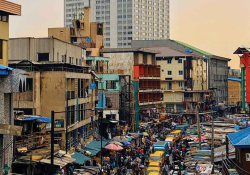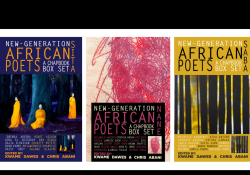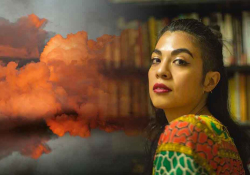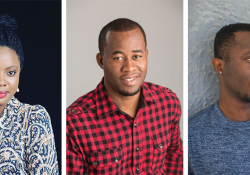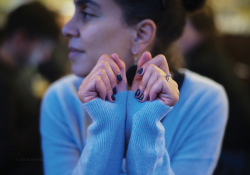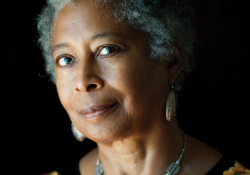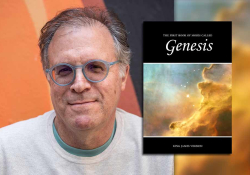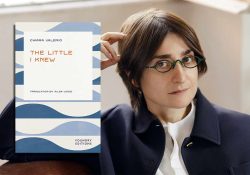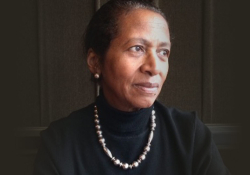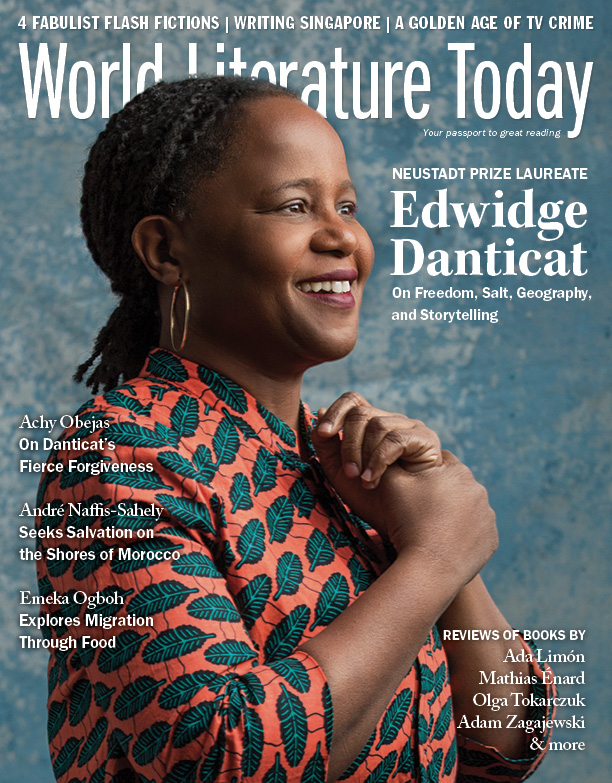“The Story Will Be There When You Need It”: A Conversation with Edwidge Danticat
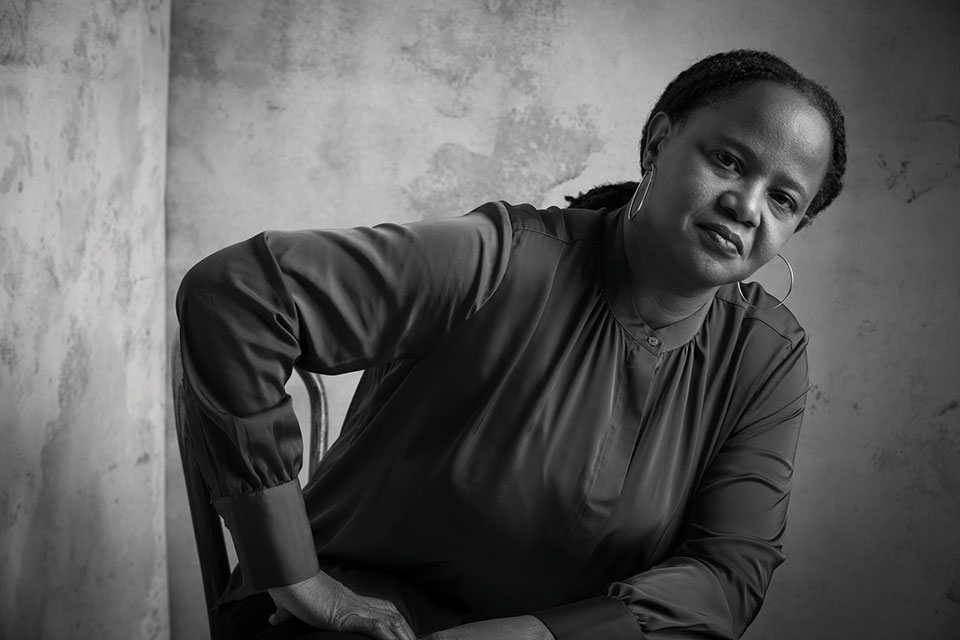
Edwidge Danticat writes about death, even the most brutal, with a lyricism that reminds us of a primal paradox—within the deepest violence and loss, the life-force reasserts itself. A mother clings to her starved newborn, a man plunges to his death reviewing moments of love, a boy trapped below earthquake rubble imagines flying a kite, a naked woman bathes quietly in the river where countless compatriots have been slaughtered. By titling her most recent book The Art of Death, Danticat explores how writers craft mortality on the page but also alludes to the possibility that wrestling with death might itself become an art. Indeed, her fiction and memoir lead us there. She sometimes uses the Creole expression lòt bò dlo, on the other side of the water, which refers either to someone who has migrated abroad or has died. These are the intertwined journeys Danticat’s stories navigate.
Erik Gleibermann: So, first of all, Edwidge, I want to say it’s an honor to be up here with you having a conversation. Our topic is death, but we may branch out into some other things. Long before you wrote The Art of Death, your most recent book, going all the way back to Breath, Eyes, Memory, almost every book, in an unflinching way, has treated that subject, I think very bravely. You have written about politically oriented massacres, executions, and death from illness in your memoirs, where you have looked closely at your own family, suicide, death in childbirth and, of course, the 2010 earthquake. Where does that come from within you to have such focus on that subject?
Edwidge Danticat: I have a very long-standing attachment to the subject, which I think begins with growing up in a family where my uncle was a minister. When I was two, my father left Haiti to move to the US, and my mom joined him when I was four, and I was left with my aunt and uncle. As part of the minister’s family, we literally had to attend every service my uncle presided over, and sometimes there would be a child baptism on Sunday. The previous Saturday there would be a funeral in the morning and a wedding in the afternoon. And I would have to go to all of these, sometimes in the same little white dress. I remember thinking about death as like these other events, the christening or the wedding. It’s a part of life.
Then realizing when people close to me would die, sometimes from illnesses that elsewhere would have been easily preventable or cured, I had to try to refigure that, to think of why I wasn’t dying. It’s a strange thought to have when you’re a little kid, but I thought I was always on the verge of dying. In Haitian Creole, if you say that someone is lòt bò dlo, on the other side of the waters, it could either mean that they’ve migrated or that they’ve died. My parents had migrated and had not died, so that complicated things a bit, but I always believed both, that I could either travel abroad or die at any time. So, it’s a subject that has always intrigued me.
Gleibermann: One thing that I find very powerful is the connection between the emergence of life and the approach of death. I’m thinking in particular of Brother, I’m Dying, your memoir from 2007. In the beginning, you find out on the same day that your father has a terminal illness and that you’re pregnant. Something that really struck me was the moment where you did the test in the bathroom. You write, “Would I die? Would the baby die? Would the baby and I both die? Would my father die before we died? Or, would we all die at the same time?” I was struck by this intertwining. Could you say something about that relationship between the coming of life and the fading of life?
If you’re a writer and married to narrative, everything is a story, and in this moment I’m in the middle of this very sad story, but at the same time there was something to rejoice.
Danticat: I feel as though I have spent my whole life hearing about and witnessing the cycle of life that is manifested in that book. But the moment you just mentioned was the first time that I felt like I was literally, as the church people say, in the gap, in that there was a life coming, my daughter, and one leaving, my father. We ended up naming my daughter Mira, which is my father’s nickname. If you’re a writer and married to narrative, everything is a story, and in this moment I’m in the middle of this very sad story, but at the same time there was also something to celebrate. The strange thing about that moment also is that the doctor didn’t tell my father he was terminal, but told me, which is very different than when my mother was diagnosed with advanced Stage 4 ovarian cancer because I felt so much relief that the doctor, who was a friend of mine, when I said I have to tell her, she said, no, that’s my job. But with my father, there was all this debate. I ended up not telling him. I think he knew. That moment of feeling the whole circularity of everything whirling around you, it was like, oh, this is where we’re all headed. It was immediate for me in that moment.
Gleibermann: Before you wrote your memoir, there is a thread of mothers dying in childbirth. Also, there’s a moment in Claire of the Sea Light where somebody says about Claire’s mother, who dies, it was like there was a battle of wills. I was struck by the idea that there’s a very complex relationship in the experience of birth that is related to death somehow.
Danticat: Part of the oral storytelling culture I grew up in had a lot of dead mothers. It’s also in the stories with the notion of the evil stepmother. There’s even a folktale about the magic orange tree where a little girl is singing to make a tree grow. She wants the tree to grow so she can get these oranges to make money because her stepmother is being mean to her. There’s a line in it, “My stepmother’s not my real mother.” My daughter loved this story. She wanted me to go to her school and sing it to the children, and I thought this line is not going to work in an American school.
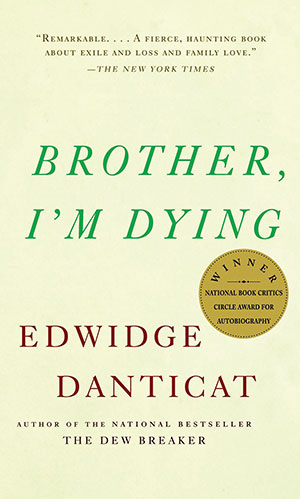
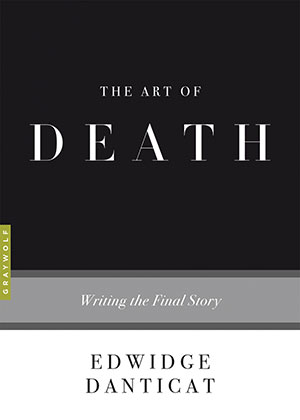 But so many of these stories about absent mothers, you realize it’s because of maternal mortality, women dying in childbirth. If you have very high maternal mortality, these stories almost prepare one for that. I was always taken by that. In a place of limited resources, like in Claire of the Sea Light, this woman is in a rural area. She might have been saved if she had had better care. In this town the poverty grows out of erosion and depletion of resources. In some cases that leads to people having to decide which child to send to school or which child to keep or to give away to another family, which is the story with Claire. With Claire and her mother, it starts from birth—who gets to live, to consume these very limited resources.
But so many of these stories about absent mothers, you realize it’s because of maternal mortality, women dying in childbirth. If you have very high maternal mortality, these stories almost prepare one for that. I was always taken by that. In a place of limited resources, like in Claire of the Sea Light, this woman is in a rural area. She might have been saved if she had had better care. In this town the poverty grows out of erosion and depletion of resources. In some cases that leads to people having to decide which child to send to school or which child to keep or to give away to another family, which is the story with Claire. With Claire and her mother, it starts from birth—who gets to live, to consume these very limited resources.
Gleibermann: You mentioned folktales, which are woven so powerfully into your work. Could you say something about how Haitian folklore and also indigenous spirituality and Vodou have influenced the way you treat the topic in your work?
Danticat: Stories, whether within the family of folktales, or just spirituality and rituals, are so important to survival, to continuity, and that’s what’s always been stressed in my family. We’re connected by our stories. You are who you are because your grandmother was this person and your mother was this person or your father was this person, and there are certain traits you carry. I’ve always wanted to incorporate that in my work. In Breath, Eyes, Memory, it’s not always positive for the most recent generation. But there are family rituals and a greater sense of spirituality, whether they’re Baptist or practice the Haitian religion of Vodou, my characters are often deeply spiritual and they tell stories that tie them to their own personal beliefs as well as to these newly acquired or ancestral and inherited faith, which they interpret for their children. I always feel there are ways stories are weaved in that keep people alive for us.
For a lot of us, especially children born outside of the country, this thing about your grandparents—you might have a beautiful black-and-white portrait and then a story that emerges when you act a certain way, and then it’s “your grandmother is just like this” and that’s all you get. When I was younger I was always told the story that I wrote about in Brother, I’m Dying about a girl who misses her father and she asks a woman to go to the land of the ancestors to get her father back. And the woman goes back and says, your father says this is his place now. For me it was just a story until my father died, and then I felt the whole weight of that story and I realized why I was told that story. You’re being prepared for certain things, and the story will be there when you need it.
Gleibermann: As you talk about the importance of story, I think about those who are born in Haiti and grew up in Haiti and are immersed and connected to the storytelling tradition. My question is about the second generation and whether their experience of grief and coping with loss is different or perhaps even more difficult if they’re not as connected to that tradition.
Danticat: Even within Haiti, when I go back and go to a family member’s funeral, the wake is very different. The wake is always a kind of party, but kids are on their phones, they’re texting, so it’s changed even within rural Haiti. It almost seems nostalgic to imagine the scene now, sitting around telling stories. There are certain demands for these wakes. It’s a different approach. It’s not as singular as it seemed to me as a child. It’s progressing more toward technology. People used to wear black based on your proximity to the person over a number of weeks or a number of years. Some things are a little more relaxed. Traditions change.
But I think what hasn’t changed is a sense of community, whether you’re burying your dead in New York or in Haiti. It always shocks people in my family where so-and-so is not invited to a funeral. To them it’s like, of course you’re invited to the funeral. You don’t need an invitation to a funeral. It’s assumed everyone will come to a funeral. For example, we were sitting next to someone at a funeral once and we asked, “How do you know so-and-so?” And the person said, “I’m visiting my mother, and she told me to buy a black shirt because we’re going to this funeral.” She said, “I don’t know the dad. I don’t know the family, but my mother does and we’re here.” You have that sense of community. The way families see it, today it might be this person’s turn. Tomorrow it might be my turn.
Before she died, many Friday nights I would call my mother from Miami, when she was in New York, and I would ask her, “What are you doing?” and she’d say, “I am going to a funeral.” She went to everybody’s funeral because that’s what you do to support the community whether you know them well or not.
Gleibermann: It seems like even if you don’t literally know the person, on some other level, you’re related. It’s not just an event that you’re attending from outside.
Danticat: I write a little about it in Brother, I’m Dying. When my mother was sick, I would find myself going to a lot of people’s funerals just as a rehearsal. It was strange. I would sit there and go through the motions in my head. In Miami, there was a time when a lot of people were coming by boat, and often they would drown. In the 1980s there was a very large number, but more recently there would be a boat and people would be dropped off, maybe not far from shore, but they wouldn’t know how to swim. There was a case of this young woman. Her family didn’t even know she was coming here, and she had gotten on this boat because she couldn’t wait for the whole process to join her fiancé, and she died. The whole community put together a funeral, and the church was packed. Her mother couldn’t even get a visa. But people came to make sure she got a proper funeral. Even if you have a difficult life, the grace of life is by having a proper funeral.
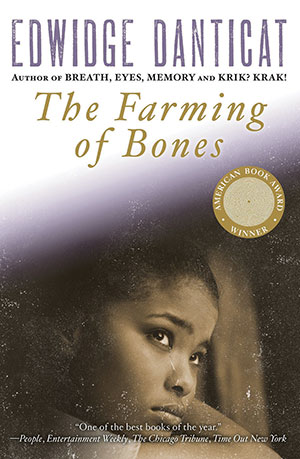
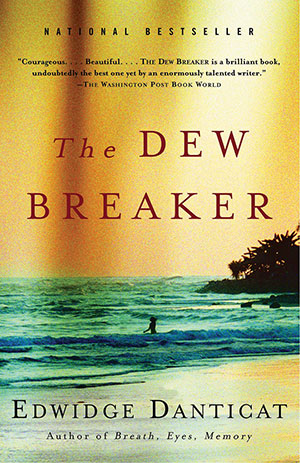 Gleibermann: I want to bring it back to fiction. Another paradox is when you describe grave violence, sometimes with such lyricism—there’s even a sense of sensuality sometimes. I’m thinking of The Farming of Bones. The Massacre River where Amabelle, at the end of the book, has lost her parents in the river, and historically, so many Haitians were killed by the Dominican government around that site. In one of the last scenes, she takes off her clothes, she goes into the river, and has a sensory experience that seems almost like an antithesis of what’s happened before in terms of what the river represents. My question is about how sensuality is connected to the experience of death.
Gleibermann: I want to bring it back to fiction. Another paradox is when you describe grave violence, sometimes with such lyricism—there’s even a sense of sensuality sometimes. I’m thinking of The Farming of Bones. The Massacre River where Amabelle, at the end of the book, has lost her parents in the river, and historically, so many Haitians were killed by the Dominican government around that site. In one of the last scenes, she takes off her clothes, she goes into the river, and has a sensory experience that seems almost like an antithesis of what’s happened before in terms of what the river represents. My question is about how sensuality is connected to the experience of death.
Danticat: The Farming of Bones, for those who haven’t read it, is a novel about the 1937 massacre of Haitian cane workers in the Dominican Republic. It actually happened just this time of year. There’s a vigil that an organization called “Border of Lights,” which is made up of Haitian and Dominican artists led by the writer Julia Alvarez, holds every year to commemorate the deaths. The main character of the book is a woman named Amabelle who is a servant in the home of a Dominican family. She’s a young woman who is in love with a man named Sebastien who goes missing during the massacre. It’s such a big story, and I read so many books. There were all the biographies of Rafael Trujillo, the dictator who ordered the massacre. I just didn’t know how to enter it. There were testimonials taken by priests of people who had crossed the border and survived.
One of the things I was reading was the story of a young woman who worked in the home of a Dominican family. The head of the family was in the army, and when the order was given, he murders her right at the table to prove his loyalty to the government. And I thought I want to write that woman’s story, but I want her to live. To talk about the different strata living in the Dominican Republic at that time and also bring in fascism in Europe and people being murdered for who they were. The grandfather from Spain was listening to very early speeches by Franco.
I was trying to bring all that through the lens of this woman. I wanted her to have this love right in the middle of all this craziness. The one positive thing she thought she had was this love for this man. She almost has in the story a voice that’s just for him, and at the end when she goes back to the spot where she thinks he’s murdered, it’s this dance of sex and death. She never gets him, but she gets to be in this place in the water. It’s kind of like Nina Simone doing an extraordinary rendition of this spiritual called “Take Me to the Water” and via that great voice of hers sounding like she is begging to be baptized. Lòt bò dlo. Another way the water is evoked. The other side of the water.
Gleibermann: It feels like a cleansing, too. I wouldn’t want to use the word baptism because the Christian iconography is not necessarily something that you’re using.
Danticat: But I think somewhere it’s cleansing for us.
Gleibermann: I want to switch to something else because I want young people to be represented in the conversation. I don’t want us to forget that you are an author of young people’s literature as well. In those works, you are also talking about the subject of death. Do you approach it differently, or how are your purposes different?
Danticat: I approach it the same way. You would speak slightly differently to an adult than you would speak to a very young child. And in the younger book, I’m writing from the point of view of a young person. I’m lucky that I have so many young people in my life to observe. I think everyone who’s written a children’s book will tell you the first rule is not to talk down to children. There’s no subject that’s off-limits, but it rings false if you talk down to children.
My first picture book was a book I wrote as a fundraiser after the 2010 earthquake. It’s called Eight Days, and it’s about a little boy who’s trapped under his house for eight days. He said, “When I came out, people asked me, what did I do?” and he said, “I played.” So, he used his imagination to pass the time.
My second picture book, Mama’s Nightingale, is about a little girl whose mom is in immigration detention. My mom was in immigration detention when I was in Haiti. She was caught in a factory raid and was detained. When I moved to Miami, I used to volunteer at a place called Boys Town where children were detained, way before we were hearing about children being detained.
My next picture book, which will come out in February, is a little bit lighter. It’s called My Mommy Medicine. It’s about what a mother and daughter do on a sick day. It’s the most fun sick day a child will ever have. A few years ago, I was intrigued by a series called Royal Diaries by Scholastic. Some of the books I read were about women like Cleopatra and the African ruler Nzingha. I wrote one about Anacaona, who was an Arawak leader from the same town, Léogâne, that my family is from. More recently, I published a book called Untwine, about twin sisters. These are books that I wish I could have had to read when I was younger.
Gleibermann: You very briefly mentioned Untwine. It has high-school-age twins. They get in a car crash and one dies.
Danticat: You just spoiled it for everyone.
Gleibermann: I was thinking that, but well, that’s early in the book. How did you come up with that? What kind of response have you gotten from young people, that scenario of twins so closely connected? It’s almost as though they’re one life, the narrator often says.
Danticat: I’ve always been so intrigued by the role of twins. In Vodou there is a whole culture of Marasa, the twin deities and even how that affects the Dosu Dosa, the person who follows the twins. In a lot of African diaspora cultures, the surviving twin literally has to carry an effigy of the lost twin. I’m also intrigued by this medical issue of people who swallow their twin in vitro. I’m obsessed with twins. There are twins in The Farming of Bones. I knew some twins when I was young. Everybody was terrified of them. They were in school with me. The teachers would say, don’t be mean to the twins. They can do things to you. So, I wanted to write about when that relationship is shattered and what that means to the person who survives. Her parents take her back to Haiti with the ashes of her twin, which are scattered in the place where they used to go together.
Gleibermann: You just answered in much richer detail about how the second generation can connect to the rituals and the culture to deal with loss. They go back to Haiti and bury the ashes.
Danticat: My Haitian American nephew, for example, loves soup joumou which most Haitians drink on January 1 to celebrate Haitian independence day, but if we didn’t explain to him that we drink this soup because at the point when we were enslaved, we couldn’t have it, how would he know that? Or maybe he would learn it by reading about it somewhere, but that knowledge has to be passed on.
Gleibermann: I want to put a little bit of spotlight on the books that are not as well known, and you mentioned Eight Days. Although that’s a children’s book, I think in The Art of Death you say that, in trying to address the enormity of the earthquake or any event that is so overwhelmingly devastating, you need to go to the particulars. Maybe an essay would talk about the larger issues, but in a narrative it’s important to go to the particulars. Could you also talk about how the earthquake has affected your writing in terms of how you talk about devastation, tragedy, mortality?
Danticat: There was an earthquake this past weekend in the north of Haiti. When people text their concern, they’ll say, “I know it wasn’t as bad as the last time,” but you think to yourself, it’s as bad as the last time for that one person. The last time they shared that pain with over two hundred thousand people. What fiction does is it draws us into that one life. I realized with The Farming of Bones that when I was trying to tell everybody’s story—in that massacre, between ten and twenty thousand people died—I didn’t have the capacity to tell the story of twenty thousand people, but one person’s story can lead us there. In high school I read The Diary of Anne Frank. For me, that was the entry into the Holocaust. That was a girl my age going through similar things as what I was going through. One story can be universal.
In The Dew Breaker, in order to write about that man, a devil with a horn on his head, I had to become someone like that. I had to step into the shoes of someone who can murder people.
Gleibermann: I’m wondering if, for you, moving through loss or understanding for yourself something that can feel so overwhelmingly big, if drawing a character helps you as a person to gain meaning or gain understanding in your grief?
Danticat: Or joy. Writing is sometimes a bit like being an actor. You really have to step into the body of the character. In The Dew Breaker, in order to write about that man, someone who could easily have been a devil with a horn on his head, I had to become someone like that. I had to step into the shoes of someone who can murder people. You have to imagine the full complexity of that choice. You have to grant a certain level of humanity to people who maybe, if you met them, you would not think they deserve. You have to think how they loved, how they lived, how they compartmentalized these things. And you also have to give them some goodness because they have people in their lives who love them. On a certain level you have to love them.
Gleibermann: I’m going to take you at your word and ask you, do you love all your characters?
Danticat: I can’t say I love all of them afterward. It’s been said that love is not necessarily the opposite of hate. Indifference is. You can’t really write with indifference. If you’re indifferent about something, you’re not going to spend two years writing about it. So, I don’t love all of them, but I feel strongly about everybody I end up writing about.

Gleibermann: You are ever-evolving as a writer, and also in themes related to mortality and death, I want to bring it toward the present. First of all, it’s been a pleasure these days to get my copy of the New Yorker each week. When I open it up, I wonder, is there a new story by Edwidge? And there has been in the last several months. In “Without Inspection,” from yet another angle you are treating the subject of death. You have a character who has several seconds left and has the experience of looking at his life. Where did that idea come from, and why did you frame the story the way you did? How does it serve what your purpose is in telling his story, a Haitian who has come ashore in South Florida?
Danticat: When I first moved to South Florida, there was and still is a big construction boom. Every once in a while you would hear about a worker in the construction site who would plunge to their death. A Haitian man once fell into one of those cement mixers. It was in the news—a great tragedy. Still, structurally, there’s something exciting about writing someone’s final 7.5 seconds alive. The whole story is supposed to last 7.5 seconds. How do you do that maneuvering? I get to think about what would be the most important thing to that person. You have to stretch the time. You can get away with things because none of us knows.
Structurally, there’s something exciting about writing someone’s final 7.5 seconds alive.
Gleibermann: You play a lot with time and time structures and flashbacks. It seems like a new wrinkle on that. What I want to ask you, though, is that it’s a short story. The previous thing I read by you was a short story. Are there more short stories coming?
Danticat: So, next summer I have a short-story collection coming out called Everything Inside. The neighborhood in Miami where I have lived for the past seventeen years has become quite gentrified. And many of the gentrifiers put scary “safety” signs on their windows. One of them said “Nothing Inside Is Worth Dying For.” The sign also had a human target on it. I thought to myself, what does that mean? I realized it means don’t come in or we’ll shoot you or you’ll die. Then I thought maybe it should be “Everything Inside Is Worth Dying For.” I wrote that into a story and it seemed like a good title, which I then shortened to just “Everything Inside.”
Gleibermann: So, there’s another story on the theme.
Danticat: All the stories are kind of on that theme, of being trespassers both where you live and in other spaces, as immigrants, even if you have the means, and refugees, particularly if you are poor. But these stories, in spite of the man falling from the building, are all love stories. Not just about romantic love, but also about familial loves and friendships.
Gleibermann: For a while you’ve been working in other genres, memoir and novels before that. Do you feel like you’re returning to the short story? I once read that that’s your first love.
Danticat: It is my first love. I love the form. You can pack so much in. It’s so economical. Some of the stories in Krik? Krak! are so short they could be vignettes. The stories in this book are much longer. I have a very short attention span. I think it also goes back to the way I was told stories initially, my storytelling roots. So short stories are perfect for my attention span.
October 10, 2018



